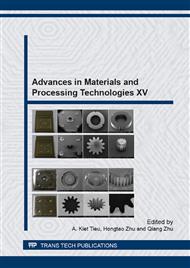p.496
p.503
p.512
p.518
p.525
p.534
p.541
p.547
p.557
Fabrication of a Hybrid Aspheric Lens Using Glass and Thermosetting Polymer Molding Technique
Abstract:
This study developed a precise hybrid optical lens (PHOL) that included polymer and glass materials. Although glass offers superior anti-thermal, anti-environmental, anti-scraped corrosion resistance and optical properties than polymer materials, it is difficult to fabricate glass materials. Therefore, it is difficult to obtain a high-accuracy aspheric glass lens. This paper presents the fabrication of a PHOL that combined aspheric polymer and glass bases using a glass-molding technique. The PHOL can be used to reduce aberration errors in optical systems using two materials. The PHOL maintains the advantages of glass materials, and the cost of aspheric polymer is lower than that of the aspheric glass layer. Thermosetting polymer was used as the aspheric part in this study. Compared to UV-curable polymer, thermosetting polymer has higher thermal stability, and the molds are not limited by glass materials, which must be transmissible by UV light. First, a glass sphere lens was used as a base of the PHOL. Subsequently, the ultra-precise diamond turning technique was used to fabricate the mold with an aspheric profile. During the molding process, the thermosetting polymer was formed into an aspheric layer and covered on the glass base. The PHOL of 11.2 mm in diameter was obtained using controlled cooling. Finally, the surface accuracy (PV) of the PHOL was less than 0.5μm, has been successfully fabricated in this study.
Info:
Periodical:
Pages:
525-533
Citation:
Online since:
November 2013
Keywords:
Price:
Сopyright:
© 2014 Trans Tech Publications Ltd. All Rights Reserved
Share:
Citation:


